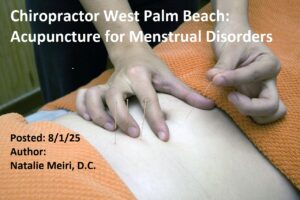
Patient Satisfaction is found to be excellent for chiropractic care! Researchers analyzing the prevalence, patterns and predictors of chiropractic utilization in the U.S. general population found that, “Back pain and neck pain were the most prevalent health problems for chiropractic consultations and the majority of users reported chiropractic helping a great deal with their health problem and improving overall health or well-being.” (1) Chiropractor West Palm Beach: Cervical Spine Anatomy and Chronic Neck Pain is about how chiropractic can help chronic neck pain.
Symptoms of Cervical Spine (Neck) Pain
Symptoms may only be stiffness or restricted range of motion. Looking over the shoulder may not be possible. And/or moving the head in any direction may be difficult. This came on insidiously for you. Finally, It is painful and muscle spasm is present.
Common muscle imbalances at or affecting the cervical spine include tightness of the sternocleidomastoids (SCMs). Also, short, deep neck extensors, upper trapezius, levator scapulae, and the pectoralis major and minor. Muscles can get inhibited (the nerve signals needed to activate and control the muscle are impaired, leading to weakness and poor function). These include the deep neck flexors. Also, the lower stabilizers of the scapulae, including the lower and middle trapezius and the rhomboids are involved. In the end, these imbalances often lead to a rounded shoulder-forward head position.

Relevant Cervical Spine Anatomy
Firstly, the cervical spine can be divided into 2 sections when describing the anatomy. The first section is the upper cervical spine consisting of the occiput (bottom of skull) and CI-C2. The second section would be the lower cervical spine (C2-C7/TI). Functionally, there is a distinction between these two sections due to the greater degree of rotation at the upper cervical spine. So the unique articulation between the C2 and C1 vertebrae allow this greater rotation. Specifically, the dens of C2 is the pivot for rotation. Additionally, there is more lax ligamentous structures in this area. Therefore, the muscles are more supportive and intricate so as to provide the stability and control. Indeed, this area has more laxity in the ligamentous system than the thoracic (mid back) and lumbar (low back) spine.
Secondly, another difference in the upper cervical spine is there is no disc between and C0, C1 and C2 levels. Discs, called intervertebral discs, are positioned between each vertebra throughout the rest of the spine.
Thirdly, neurologically, the upper cervical spinal cord has a unique connection with the central nervous system. This is through the trigeminocervical nucleus (functional convergence zone in the upper cervical spinal cord where sensory nerve fibers from the face (via the trigeminal nerve) and the upper neck (C1-C3 spinal nerves) meet. Here there is an intermingling of the spinal nucleus of the trigeminal nerve and the dorsal horn of the upper cervical spinal nerves. This is an anatomical explanation for the cause of headaches, dizziness, and facial pain.
Chiropractor West Palm Beach: Cervical Spine Anatomy and Chronic Neck Pain Connection…
The cervical spine has the task of maintaining head posture while allowing for a great deal of mobility. Moreover, the cervical spine must balance the weight of the head atop a relatively thin and long lever. This makes it quite susceptible to traumatic forces. The cervical facets (paired joints in neck) allow movement in all directions. In fact, the cervical spine is therefore the most movable portion of the spine. Anatomically, it is quite vulnerable.
Causes of Neck Pain from Daily Stresses
Incorrect posture, obesity and weak abdominal muscles often disrupt spinal alignment. This leads your neck to bend forward to compensate. Stress and emotional problems can cause muscles to tighten and contract, resulting in pain and stiffness. Postural stress can contribute to chronic neck pain. Symptoms can eventually extend into the upper back and the arms.
Dentists, mechanics, plumbers, electricians, and various technicians can be in awkward positions for prolonged periods. Any particular position may cause pain. So many neck structures can be stretched or compressed.
There are repetitive sports injuries to the neck. These may become chronic due to lack of proper treatment.

Research For Neck Pain Relieved by Chiropractic Care
There was a recent study funded by NIH’s National Center for Complementary and Alternative Medicine. It was to test the effectiveness of different approaches for treating mechanical neck pain. 272 participants were divided into groups. They received either spinal manipulative therapy (SMT) from a doctor of chiropractic (DC) or pain medication. It lasted for 12 weeks. About 57 percent of those who met with DCs reported at least a 75 percent reduction in pain. In comparison, only 33 percent of the people in the medication group reported pain reduction. After one year, approximately 53 percent of the drug-free groups continued to report at least a 75 percent reduction in pain. And this compared to just 38 percent pain reduction among those who took medication.
Chiropractor West Palm Beach: Cervical Spine Anatomy and Chronic Neck Pain
Dr. Natalie Meiri will examine you and come up with a treatment plan to get you better! Through regular chiropractic visits, you can get pain relief and improve your health without drugs or surgery. Indeed, although aging is a slow and progressive deterioration of bodily functions the body can be maintained by proper care.
Make an appointment today at 561-253-8984! And/or call to find out more about Chiropractor West Palm Beach: Cervical Spine Anatomy and Chronic Neck Pain.
References: (1 ) Adams et al (2017) Spine




















